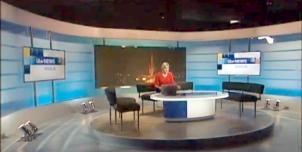Full Freeview on the Tacolneston (Norfolk, England) transmitter
| Google Streetview | Google map | Bing map | Google Earth | 52.518,1.139 or 52°31'6"N 1°8'22"E | NR16 1DW |
The symbol shows the location of the Tacolneston (Norfolk, England) transmitter which serves 330,000 homes. The bright green areas shown where the signal from this transmitter is strong, dark green areas are poorer signals. Those parts shown in yellow may have interference on the same frequency from other masts.
This transmitter has no current reported problems
The BBC and Digital UK report there are no faults or engineering work on the Tacolneston (Norfolk, England) transmitter._______
Digital television services are broadcast on a multiplexes (or Mux) where many stations occupy a single broadcast frequency, as shown below.
64QAM 8K 3/4 27.1Mb/s DVB-T MPEG2
DTG-12 QSPK 8K 3/4 8.0Mb/s DVB-T MPEG2
H/V: aerial position (horizontal or vertical)
Which Freeview channels does the Tacolneston transmitter broadcast?
If you have any kind of Freeview fault, follow this Freeview reset procedure first.Digital television services are broadcast on a multiplexes (or Mux) where many stations occupy a single broadcast frequency, as shown below.
64QAM 8K 3/4 27.1Mb/s DVB-T MPEG2
DTG-12 QSPK 8K 3/4 8.0Mb/s DVB-T MPEG2
H/V: aerial position (horizontal or vertical)
Which BBC and ITV regional news can I watch from the Tacolneston transmitter?

BBC Look East (East) 0.8m homes 3.2%
from Norwich NR2 1BH, 16km northeast (37°)
to BBC East region - 27 masts.
70% of BBC East (East) and BBC East (West) is shared output

ITV Anglia News 0.8m homes 3.2%
from NORWICH NR1 3JG, 16km northeast (38°)
to ITV Anglia (East) region - 26 masts.
All of lunch, weekend and 80% evening news is shared with Anglia (West)
Are there any self-help relays?
| Gt Yarmouth | Transposer | 1 km S town centre | 30 homes |
| Lowestoft (2) | Transposer | Rotterdam Rd | 125 homes |
How will the Tacolneston (Norfolk, England) transmission frequencies change over time?
| 1950s-80s | 1984-97 | 1997-98 | 1998-2011 | 2011-13 | 2013-18 | 2013-17 | 17 Jul 2018 | ||
| VHF | C/D E | C/D E | C/D E | E | E T | W T | W T | ||
| C3 | BBCtvwaves | ||||||||
| C31 | com7 | com7 | |||||||
| C32 | _local | ||||||||
| C37 | com8 | com8 | |||||||
| C39 | +ArqB | +ArqB | ArqB | ||||||
| C40 | BBCA | ||||||||
| C42 | SDN | SDN | SDN | SDN | |||||
| C43 | D3+4 | ||||||||
| C45 | ArqA | ArqA | ArqA | ArqA | |||||
| C46 | BBCB | ||||||||
| C50tv_off | BBCB | BBCB | |||||||
| C52tv_off | C5waves | C5waves | |||||||
| C55tv_off | BBC2waves | BBC2waves | BBC2waves | -BBCA | -BBCA | -BBCA | com7tv_off | ||
| C56tv_off | COM8tv_off | ||||||||
| C57tv_off | LNR | LNR | |||||||
| C59tv_off | ITVwaves | ITVwaves | ITVwaves | -D3+4 | -D3+4 | -D3+4 | |||
| C62 | BBC1waves | BBC1waves | BBC1waves | BBCB | |||||
| C65 | C4waves | C4waves | C4waves |
tv_off Being removed from Freeview (for 5G use) after November 2020 / June 2022 - more
Table shows multiplexes names see this article;
green background for transmission frequencies
Notes: + and - denote 166kHz offset; aerial group are shown as A B C/D E K W T
waves denotes analogue; digital switchover was 9 Nov 11 and 23 Nov 11.
How do the old analogue and currrent digital signal levels compare?
| Analogue 1-4 | 250kW | |
| SDN, ARQA, ARQB, BBCA, D3+4, BBCB | (-4dB) 100kW | |
| com7 | (-9.6dB) 27.4kW | |
| com8 | (-10.2dB) 24kW | |
| Mux 1*, Mux 2*, LNR | (-14dB) 10kW | |
| Mux A*, Mux B*, Mux C*, Mux D* | (-17dB) 5kW | |
| Analogue 5 | (-18dB) 4kW |
Local transmitter maps
Tacolneston Freeview Tacolneston DAB Tacolneston TV region BBC East Anglia (East micro region)Which companies have run the Channel 3 services in the Tacolneston transmitter area
|
|
Wednesday, 14 February 2018
S
StevensOnln14:57 PM
clive Holgate: COM7 & COM8 are not closing in March, they are moving to form single frequency networks on UHF channels 55 and 56 (COM8 has already moved at Tacolneston and COM7 will move on 6th June according to Digital UK). Interference from 4G mobile services in the 800MHz band was much lower than expected and in the vast majority of cases is resolved by fitting a free filter from at800.tv and it is anticipated that this will be no worse when 4G/5G services being in the 700MHz band from the second half of 2020. It is necessary to use low frequencies (i.e. lower than 1GHz) as they allow the mobile networks to achieve coverage over a much greater distance and penetrate buildings much better than higher frequencies. Various other frequency bands will become available for use by the mobile networks over the next few years, but they are all at higher frequencies which are only useful over a short range and will struggle to provide coverage over rural areas, but will be extremely useful to provide network capacity in towns and cities where there is already a heavy demand for mobile broadband access which will only increase.
| link to this comment |
Friday, 16 February 2018
C
clive Holgate1:15 PM
BUT i read on this website after march chs above 49 will not be used for tv , i agree the use of lower freq is needed to give the 4G coverage but there is many spare spaces below 1ghz without messing up the already messed up tv band , i disagree 4G caused few problems i install aerials in east suffolk and have had many calls from people who had broken tv signals problem in this area is no one wants to use aldeburgh because of lack of chs so everyone had aerials installed for norwich / sudbury with mast amps which were installed many years before 4G was planed the at800tv people didnt want to know about fitting a filter on rooftops so i did quite well out of it so no complaints from me but from customers point the whole thing is daft, ofcom need head testing to allow this to happen , just look how many houses the watertower at saxmundham overlooks several hundred
| link to this comment |
S
StevensOnln13:35 PM
clive Holgate: The 700MHz clearence program is taking place between now and May 2020 (after consultation with the industry, Ofcom were able to bring the completion date forward from the originally announced date in 2022 so that the 700MHz band could be made available for mobile services earlier). The use of 700MHz for mobile services has been agreed by broadcasters and telecoms companies across Europe (through the European Broadcasting Union, similarly to how the use of 800MHz was previously agreed) in order harmonise the use of radio spectrum that that devices sold in country are able to used across the Europe. Frequency planning has been carried out that enables 90% of UK households to retain access to a six multiplex service beyond 2020, with a program to provide free replacement aerials to households who need them. Frequency bands below UHF are not generally suitable for mobile broadband services and I understand that there are currently no other frequency bands available for use below 2.3GHz (which is about to be auctioned by Ofcom for mobile broadband use) that aren't already being used by mobile networks or other users. Please explain how any of this is a mess.
| link to this comment |
Saturday, 17 February 2018
H
hardy9:39 AM
I suspect that many of the people posting with problems on this site are using a group C/D aerial. . travelling around Norfolk I see many of these still on house roofs . Group C/D aerials do not work well on UHF channels 31 and 37 . Up until recently 31 and 37 carried com 7 and 8. Com 8 reception with these aerials should now be much better because they have high sensitivity on UHF channel 56. COM7 will improve too when it moves to 55 in june.
However all technical experts recommend that the majority of housholds should now be using a wideband aerial to accommodate all possible future frequency changes . Help with aerial change is available in difficult reception areas.
Could I appeal again that it helps greatly with replying to problems to know the area you live and if possible the group , size and position of your aerial . (or at least the approximate age of the aerial)
| link to this comment |
Wednesday, 21 February 2018
C
Chris W5:54 PM
Is there some good reason why com7 and com8 are transmitted at reduced power? Living near Aldeburgh I am now getting a poorer signal on channel 56 than before and my nice new BT Youview box is struggling. Oddly my Sony bravia is ok.
| link to this comment |
S
StevensOnln17:23 PM
Chris W: Because if they were broadcast at a higher power level they would cause all sorts of problems with interference, both with reception from other UK transmitters as well as potentially causing interference for viewers in The Netherlands, Belgium and Northern France where there are transmitters operating on the same frequencies.
| link to this comment |
Thursday, 22 February 2018
H
hardy9:30 PM
Its optimistic to try to get UHF channel 56 from Aldeburgh . Its in a shadow relative to the Tacelston signal. And needs a good horizontally polarised aerial. Probably a group CD group K or high gain wideband. Wheras you should have a strong signal from the local Alderburgh relay transmitter which requires a vertically polarised group A aerial. (of course the relay does not carry com7 or com8 so I can see why you might try for Tacolneston)
| link to this comment |
Tuesday, 27 February 2018
C
Chris W9:12 AM
Saxmundham
Thanks for the feedback. I should have clarified that I was talking about getting the Channel 56 signal from Tacolneston from my location which is about halfway between Aldeburgh and Saxmundham. I am currently using a Televes DAT45 aerial which is quite high gain. Annoyingly my Sony Bravia TV will extract a stable signal from Channel 56 but my brand-new BT YouView box won't. I don't know whether a more expensive Humax box would do better?
It seems to me that it's a job not completed if despite all the channel reorganisation some channels will still have only limited reception!
| link to this comment |
Chris's: mapC's Freeview map terrainC's terrain plot wavesC's frequency data C's Freeview Detailed Coverage
H
hardy11:47 AM
Chris I get channel 56 on a humax youview box fine with a log aerial plus amplifier at 20 miles from Tacolneston. A DAt45 aerial has a higher gain at 56 so should be ok at your location with an amplifier (30 miles?) Its true that some tvs/boxes are more sensitive than others.
by "amplifier" I mean a proper one mounted next to the aerial not a cheap indoor one.
| link to this comment |
Thursday, 8 March 2018
S
Stephen4:51 PM
Great Yarmouth
NR31 9NE. I seem to have lost UHF channel 37 (BT Showcase). Any suggestions
| link to this comment |
Stephen's: mapS's Freeview map terrainS's terrain plot wavesS's frequency data S's Freeview Detailed Coverage
Select more comments
Your comment please!





